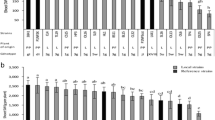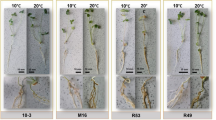Summary
Soil samples from several European countries; Sweden, the Netherlands, Spain, Italy and Greece, contained rhizobial populations capable of forming an effective symbiosis with the cultivated pea cv. Rondo from the Netherlands. The range of variation among the European Rhizobium strains, as expressed on pea cv. Rondo, was not so large and almost the same variation could be found within the rhizobial population within each country. Superior Rhizobium strains for the Dutch pea were not restricted to soils from the Netherlands but were also found in those from Sweden and Italy.
Soils from Turkey and Israel also contained Rhizobium strains capable of nodulating pea cv. Rondo. However, the genetic variation among these Middle East Rhizobium strains was much larger than that of the European strains. When tested on pea cv. Rondo the majority of the Middle East strains belonged to the medium or low effective classes and only a few strains were comparable with European Rhizobium strains.
Dutch Rhizobium strains induced effective nodules on both the Dutch pea cv. Rondo and the Swedish cv. L 110. However, in association with a Turkish Rhizobium strain effective nodules were formed on pea cv. Rondo and ineffective nodules on cv. L 110.
We suggest that the genetic uniformity of EuropeanR. leguminosarum strains is the result of selection and domestication of Rhizobium strains originally derived from the gene centres of the pea plant.
Similar content being viewed by others
References
Bennett E 1970 Adaptation in wild and cultivated plant populations.In Genetic Resources in Plants — their Exploration and Conservation. Eds. O H Frankel and E Bennett.pp 115–129. Blackwell Scientific Publications, Oxford and Edinburgh.
Hiele F J H van 1960 Enting van lupinen, erwten en stambonen met verschillende Rhizobiumstammen; veldproeven. Verslagen Landbouwk. Ond. no. 66. 19 Pudoc, Wageningen.
Janssen B H 1970 Soil Fertility in the great Konya Basin, Turkey, Pudoc, Wageningen.
Lamprecht H 1974 Monographie der Gattung Pisum. Steiermärkische Landesdruckerei, Graz.
Leppik E E 1970 Gene centres of plants as sources of disease resistance. Annu. Rev. Phytopathol. 8, 324–344.
Lie T A 1978 Symbiotic specialisation in pea plants: the requirement of specific Rhizobium strains for peas from Afghanistan. Ann. Appl. Biol. 88, 462–465.
Lie T A 1981 Gene centres a source for genetic variants in symbiotic nitrogen fixation: host-induced ineffectivity inPisum sativum L. ecotype fulvum. Plant and Soil 61, 125–134.
Lie T A, Hille Ris Lambers D and Houwers A 1976 Symbiotic specialisation in pea plants: some environmental effects on nodulation and nitrogen fixation.In Symbiotic Nitrogen Fixation in Plants. Ed. P S Nutman, 319–333. Cambridge Univ. Press, Cambridge.
Lie T A, Winarno R and Timmermans P C J M 1978 Rhizobium strains isolated from wild and cultivated legumes: suppression of nodulation by a non-nodulating Rhizobium strain.In Microbial Ecology. Eds. M W Loutit and J A R Miles, 398–401. Springer Verlag, Berlin Heidelberg New York.
Lie T A, Timmermans P C J M and Ladizinsky G 1982 Host-controlled nitrogen fixation in the legume-Rhizobium symbiosis: incompatibility ofPisum sativum L. ecotypeelatius Bieb. andabyssinicum Braun with EuropeanRhizobium leguminosarum strains. Isr. J. Bot. 31, 163–167.
Schneibe A 1934 Über Vorkommen und Nutzungsweise der Wilderbse (Pisum elatius Stev.) und der Wildbohne (Vicia narbonensis var. intermedia Strobl.) in Anatolien. Der Züchter 6, 234–240.
Vavilov N I 1951 The origin, variation, immunity and breeding of cultivated plants (English translation). The Ronald Press Co., New York.
Winarno R and Lie T A 1979 Competition between Rhizobium strains in nodule formation: interaction between nodulating and non-nodulating strains. Plant and Soil 51, 135–142.
Wieringa K T and Bakhuis J A 1957 Chromatography as a means of selecting effective strains of Rhizobia. Plant and Soil 8, 254–262.
Zohari D 1970 Centres of diversity or centers of origin.In Genetic Resources in Plants — their Exploration and Conservation. Eds. O H Frankel and E Bennett, 33–42. Blackwell Scientific Publications, Oxford and Edinburgh.
Author information
Authors and Affiliations
Rights and permissions
About this article
Cite this article
Lie, T.A., Göktan, D. Gene centres, a source for genetic variants in symbiotic nitrogen fixation: The symbiotic response of the cultivated pea toRhizobium leguminosarum strains from Europe and the Middle East. Plant Soil 82, 359–367 (1984). https://doi.org/10.1007/BF02184273
Issue Date:
DOI: https://doi.org/10.1007/BF02184273




